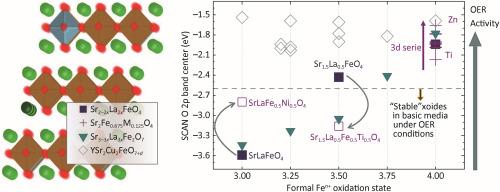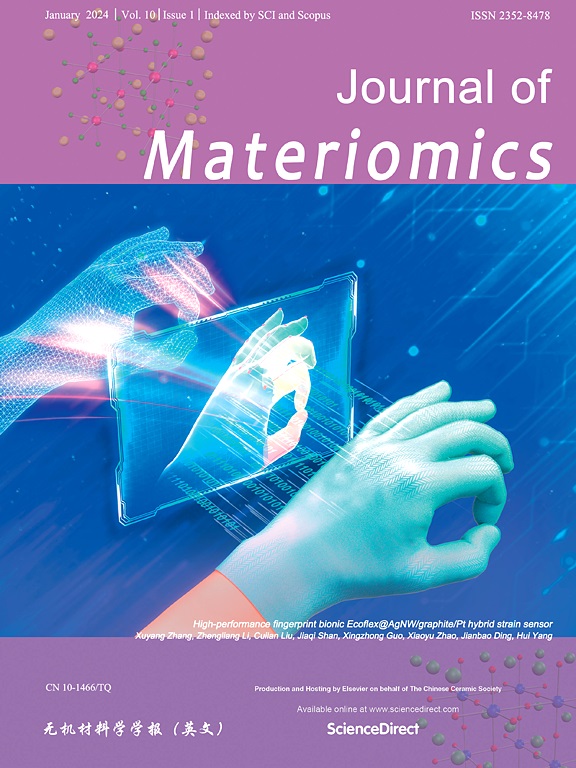DFT insights on iron-based layered perovskites as oxygen catalysts
IF 9.6
1区 材料科学
Q1 CHEMISTRY, PHYSICAL
引用次数: 0
Abstract
Density Functional Theory (DFT)-derived electronic descriptors are key to accelerating the design of effective ORR/OER catalysts. The O 2p-band center, in particular, is a robust descriptor of catalytic activity in perovskite oxides. This study examines the O 2p-band center in Fe4+ perovskite-type layered oxides, focusing on the Ruddlesden Popper (RP) phases Sr2FeO4 and Sr3Fe2O7, as well as the high-Tc superconductor YSr2Cu2FeO8. The analysis emphasizes trends driven by compositional modifications. The O 2p-band centers of Sr2–2xLa2xFeO4 and Sr3–3xLa3xFe2O7 (0 < x < 1) correlate linearly with the Fe oxidation state, and span a wide energy range (–1.2 eV to –4.7 eV with PBE+U; –1.9 eV to –4.7 eV with SCAN). Partial substitution of Fe with 3d transition metals (TM) in Sr2Fe7/8xM1/8O4 shifts the O 2p band center, with the more electronegative TMs bringing it closer to the Fermi level. RP-Sr2FeO4 exhibits remarkable tunability of the O 2p-band center, enabling the compositionally driven design of oxygen catalysts with potentially improved activity–stability balance. In contrast, YSr2Cu2FeO7+δ (0 < δ < 1) shows no correlation between the O 2p-band center and Fe oxidation states, likely due to a change in Fe coordination from octahedral (δ = 1) to tetrahedral (δ = 0). The O 2p-center values (–0.9 eV to –1.3 eV with PBE+U; –1.5 eV to –2 eV with SCAN) suggest that YSr2Cu2FeO7+δ could potentially catalyze the ORR/OER, though stability over operation time remains a challenge.

铁基层状钙钛矿作为氧催化剂的DFT研究
密度泛函理论(DFT)衍生的电子描述符是加速设计有效ORR/OER催化剂的关键。特别是o2p -带中心,是钙钛矿氧化物催化活性的有力描述符。本研究考察了Fe4+钙钛矿型层状氧化物中的O 2p-带中心,重点研究了Ruddlesden Popper (RP)相Sr2FeO4和Sr3Fe2O7,以及高tc超导体YSr2Cu2FeO8。分析强调由成分变化驱动的趋势。Sr2-2xLa2xFeO4和Sr3-3xLa3xFe2O7的O - 2p波段中心(0 < x < 1)与Fe氧化态呈线性相关,且能量范围较宽(PBE+U为-1.2 eV至-4.7 eV; SCAN为-1.9 eV至-4.7 eV)。在Sr2Fe7/8xM1/8O4中,三维过渡金属(TM)部分取代Fe使o2p带中心移位,电负性越强的TM使其更接近费米能级。RP-Sr2FeO4表现出明显的o2o -波段中心可调性,使氧催化剂的组成驱动设计具有潜在的改善活性-稳定性平衡。相比之下,YSr2Cu2FeO7+δ (0 < δ < 1)在O 2p-带中心和铁氧化态之间没有相关性,可能是由于铁的配位从八面体(δ = 1)转变为四面体(δ = 0)。o2o中心值(PBE+U为-0.9 ~ -1.3 eV; SCAN为-1.5 ~ -2 eV)表明,YSr2Cu2FeO7+δ可能催化ORR/OER,但稳定性仍是一个挑战。
本文章由计算机程序翻译,如有差异,请以英文原文为准。
求助全文
约1分钟内获得全文
求助全文
来源期刊

Journal of Materiomics
Materials Science-Metals and Alloys
CiteScore
14.30
自引率
6.40%
发文量
331
审稿时长
37 days
期刊介绍:
The Journal of Materiomics is a peer-reviewed open-access journal that aims to serve as a forum for the continuous dissemination of research within the field of materials science. It particularly emphasizes systematic studies on the relationships between composition, processing, structure, property, and performance of advanced materials. The journal is supported by the Chinese Ceramic Society and is indexed in SCIE and Scopus. It is commonly referred to as J Materiomics.
 求助内容:
求助内容: 应助结果提醒方式:
应助结果提醒方式:


